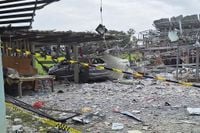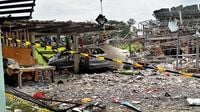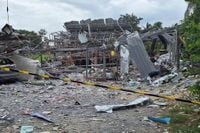At least nine people lost their lives and two others were critically injured following a devastating explosion at a fireworks workshop in Suphan Buri province, central Thailand, on Wednesday morning, July 30, 2025. The blast occurred in the Muang district, approximately 95 kilometers northwest of Bangkok, in the heart of Thailand’s central rice-growing region, leaving behind shattered wooden buildings and a scene cordoned off due to fears of further explosions.
Local authorities and rescue teams rushed to the site shortly after the explosion, which happened around 11:00 AM local time (04:00 GMT). The Samerkun Suphan Buri Rescue Foundation confirmed nine fatalities and reported that two individuals were taken to hospital in critical condition. The provincial government’s public relations department also noted that one person had been injured, though details about missing persons remain unclear.
Police Senior Sergeant Major Pinyo Chanmanee explained that the explosion occurred in a building used for producing fireworks. However, it remains uncertain whether the workshop held a valid license for such operations. Adding to the complexity, some media outlets have suggested that the site was involved in the illegal production of bird-scaring firecrackers, a type of firework commonly used in agricultural settings to protect crops.
Eyewitness accounts and video footage from the scene depicted the destruction of two houses and a car amid green rice fields, highlighting the rural setting of the tragedy. All nine victims were Thai women, including one who was reportedly eight months pregnant. The loss of life has sent shockwaves through the local community, with the governor of Suphan Buri province and other officials visiting the site to oversee rescue efforts and investigate the incident.
This tragic event is not isolated. Suphan Buri province was the site of a similarly deadly fireworks factory explosion in January 2024, which claimed approximately 20 lives. Moreover, in July 2023, a massive blast at a fireworks warehouse in southern Thailand’s Narathiwat province killed at least 10 people and wounded over 100. These repeated incidents have raised serious concerns about safety regulations and enforcement in Thailand’s fireworks industry.
The Ministry of Industry had previously announced intentions to amend laws governing the establishment and operation of fireworks factories following the January 2024 disaster. Despite these efforts, the recurrence of such deadly explosions suggests that regulatory measures may not yet be sufficient or fully implemented.
Fireworks production is a hazardous business, especially when safety protocols are inadequate or ignored. Firecrackers and fireworks contain explosive materials that require strict handling procedures. The illegal manufacturing of bird-scaring firecrackers, if confirmed, adds another layer of risk, given the unregulated nature of such operations.
The Thai government has also been dealing with other security challenges, such as a state of emergency declared in eight districts of two provinces due to border conflicts with Cambodia. While unrelated, these tensions contribute to a broader context of instability and strain on local resources.
Officials have cordoned off the area of the explosion to prevent further casualties, as the risk of additional detonations remains high. Investigations are ongoing to determine the exact cause of the blast, whether it was accidental or related to unsafe manufacturing practices.
For the families of the victims and the community of Suphan Buri, the tragedy is a grim reminder of the dangers inherent in fireworks production. The repeated loss of life calls for urgent action to improve safety standards, enforce licensing requirements, and crack down on illegal operations.
As rescue teams continue their work and investigations proceed, the hope is that lessons learned from this disaster will lead to stronger protections for workers and residents alike, preventing such a catastrophe from happening again in Thailand’s vibrant yet perilous fireworks industry.



